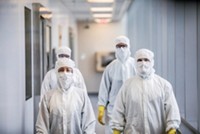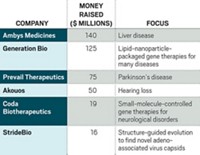Advertisement
Grab your lab coat. Let's get started
Welcome!
Welcome!
Create an account below to get 6 C&EN articles per month, receive newsletters and more - all free.
It seems this is your first time logging in online. Please enter the following information to continue.
As an ACS member you automatically get access to this site. All we need is few more details to create your reading experience.
Not you? Sign in with a different account.
Not you? Sign in with a different account.
ERROR 1
ERROR 1
ERROR 2
ERROR 2
ERROR 2
ERROR 2
ERROR 2
Password and Confirm password must match.
If you have an ACS member number, please enter it here so we can link this account to your membership. (optional)
ERROR 2
ACS values your privacy. By submitting your information, you are gaining access to C&EN and subscribing to our weekly newsletter. We use the information you provide to make your reading experience better, and we will never sell your data to third party members.
Gene Therapy
Novartis to expand gene therapy pipeline with acquisition of AveXis for $8.7 billion
AveXis is developing therapies for genetic diseases of the nervous system, including spinal muscular atrophy
by Ryan Cross
April 13, 2018
| A version of this story appeared in
Volume 96, Issue 16
Novartis plans to acquire the neurological gene therapy firm AveXis for $8.7 billion. The purchase will bolster the Swiss giant’s standing as a big pharma leader in the emerging gene therapy field.
AveXis’s leading drug candidate is its gene therapy to treat infants with spinal muscular atrophy type 1 (SMA1), a devastating genetic disease, sometimes called “floppy baby syndrome,” that causes weak muscles and difficulty breathing. Only 8% of afflicted infants survive to 20 months.
In November, a study showed that all 15 infants treated with AveXis’s gene therapy for SMA1 were alive after 20 months (N. Engl. J. Med. 2017, DOI: 10.1056/nejmoa1706198). “Those kids were dying, and the outcomes look really good at this point,” Mark A. Kay, a director of the human gene therapy program at Stanford University School of Medicine, told C&EN in November when the study was released.
Gene therapy enthusiasm grew even more in December when Luxturna became the first gene therapy approved by the U.S. Food & Drug Administration to treat genetic disease. Developed by Spark Therapeutics, Luxturna is a pair of one-time injections, with a price tag of $850,000, that treats a rare form of inherited blindness. In January, Novartis acquired rights to develop Luxturna outside the U.S.
Novartis expects to fund the AveXis purchase with the $13 billion it will make from selling its stake in a consumer health care joint venture with GlaxoSmithKline.
SMA1 is caused by genetic mutations in the gene SMN1. AveXis packages a healthy copy of SMN1 into a viral delivery vessel called adeno-associated virus 9 (AAV9), which it licensed from Regenxbio. When injected into the blood, AAV9 is able to cross the nervous system’s protective blood-brain barrier and enter the brain and spinal cord—an obstacle that has stalled many promising therapies aimed at the nervous system.
The proposed acquisition shows that Novartis is not scared about the potential risks of high-dose gene therapy. The SMA1 therapy uses an extraordinary number of DNA-stuffed viruses—200 trillion per kilogram of body weight—to ensure that enough of the therapy actually gets into the diseased cells of the infant.
A similarly high dose caused a brief panic among investors in February when a study disclosed toxic, sometimes deadly, effects from an SMA therapy tested in monkeys and piglets. It used an AAV related to, but different from, AAV9.
Many challenges remain for developing and commercializing gene therapies. “Manufacturing was a real issue early on and is still an issue,” Kay said. Not only is consistent manufacturing difficult, but many gene therapy firms are facing long waits from contract manufacturers to get the AAV viruses needed to develop their therapies. In fact, the facility in Libertyville, Ill., where AveXis manufactures AAV9, is another reason Novartis is excited about the company.
AveXis is using AAV9 to develop therapies for two more neurological conditions: Rett syndrome and amyotrophic lateral sclerosis. AveXis CEO Sean Nolan earlier told C&EN that since the same AAV9 is used, and the only major change is the gene stuffed inside, the therapies might enter the clinic fairly quickly.





Join the conversation
Contact the reporter
Submit a Letter to the Editor for publication
Engage with us on Twitter